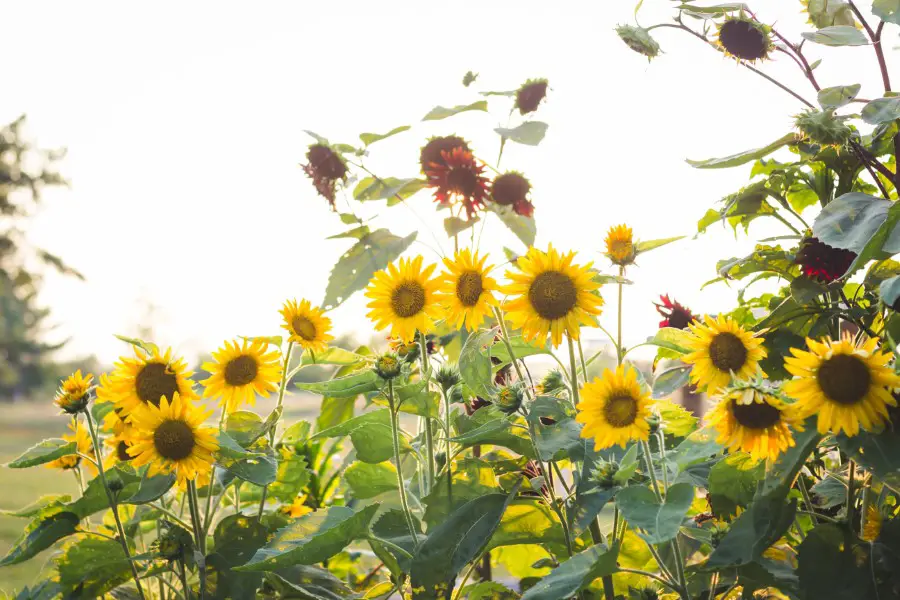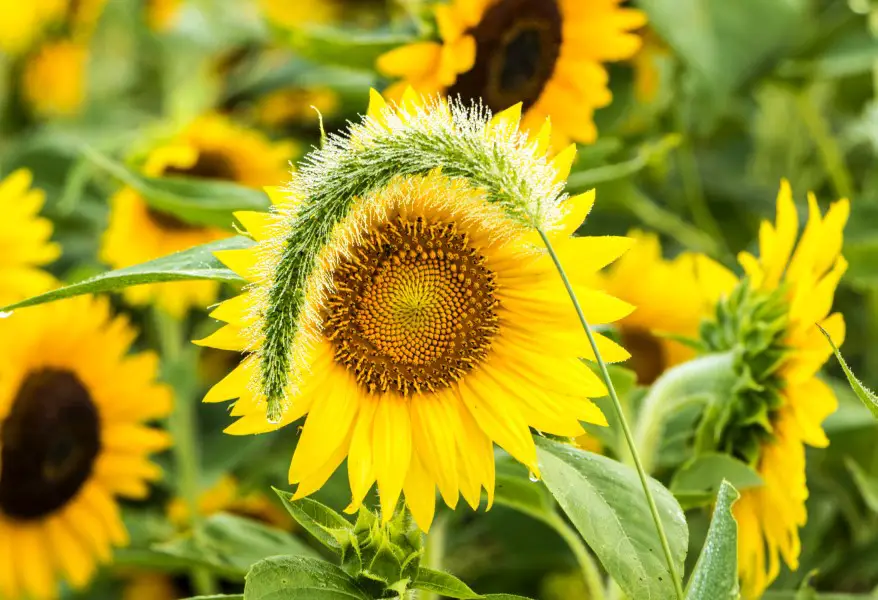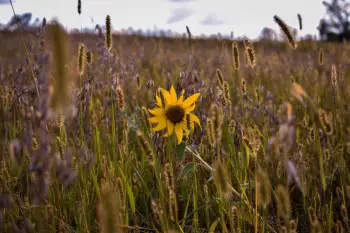Before you get out the weed killer, let’s make sure that little yellow looking weed isn’t actually a sunflower! But is it a weed or not? Are ALL sunflowers weeds? I’d like to … of course say a definite no! But I thought I’d better look into this a little bit more before I say it with pride and confidence! So here goes.
So are sunflowers weeds? Weed is often used to describe unwanted species of plants. One might call a sunflower a weed, another might call it a blessing. Even though wild sunflowers occur ‘in the wild’, they’re very similar to those people cherish in their gardens. So what’s the difference? Let’s explore what we mean further.
It all started in a soybean field in Kansas City in 1966, where a farmer was spraying crop fields and it so happened that some of the weeds survived!
They were in fact Sunflower ‘Weeds’. Native Wild sunflower seeds was the description given. Why they survived isn’t necessarily the important factor, at least not in this article. Here we’re trying to find out why he referred to them as weeds and whether they are in fact … weeds! Or indeed, why they were referred to as Native Wild Sunflowers – what does it all mean?
Chernobyl
After the nuclear accident in 1986, fields of Sunflowers were planted to soak up radiation and clean the soil in chernobyl. A hero of the plant world, if ever there was one.
“If they are a weed, then they’re a weed that we need”
Pamela Anne.
Definition of a Weed
Let’s start with the definition of a weed. We could all easily describe them as unwanted plants that do nothing to adorn our gardens, verandas or patios. Pests that just won’t seem to go away and grow far more rapidly than any plant we can think of! At every time of the year too.
Isn’t that what a sunflower does too? Not only that, but what about the wild orchids that are so lovely, or the poppy … which by the way symbolizes so much we have come to remember! Are we therefore classifying these as weeds too?
dictionary.com defines weeds as:-
- a valueless plant growing wild, especially one that grows on cultivated ground to the exclusion or injury of the desired crop.
- any undesirable or troublesome plant, especially one that grows profusely where it is not wanted.
This seems rather harsh, it would especially seem harsh when applied to poppy’s, orchids and obviously … sunflowers. Am I being biased? Perhaps.
So Who Decides What Is a Weed?
It seems there are two main definitions, or better still, perspectives, that we can apply to ‘weeds’ and it’s not down to the plant itself, it’s down to the individual making the claim or the context in which we find the plant growing.
In the case of farmers, they see weeds as flora and fauna that interferes with their crop growing and harvesting routines. They require spraying with various chemicals so the crop yield remains intact. This is understandable. For them there is an investment they need to keep safe.
The other form, it seems, is for those households that see a plant, (weed), that is simply not wanted in the place it is growing.
In truth, many green looking weeds do have a tendency to grow in the places you don’t want … in between flagstones and the like. But again this seems to be down to the individual and their own tastes.
“A weed is a plant whose virtues have not yet been discovered”
Ralph Waldo Emerson

Is a Sunflower a Weed?
Some people do in fact find sunflowers scary, but that’s a whole new article and in fact I mention that in a later post and many other Fantastic Features about Sunflowers.
To some perhaps they’re a weed, to others they’re a valued crop. To me they are certainly not a weed – but my neighbor might see it differently.
Whether it’s in between flagstones or not, it’s a wonderful plant to have around – unwanted or not. Someone somewhere would love to admire it, even if perhaps a few don’t.
In Kansas, the sunflower has been adopted as their state flower. Whilst in Iowa, the plant is listed as a ‘noxious weed’. So the difference in perceptions go beyond single people to whole groups of people. Yet they’re found in all the best florists, they’re a main Sunflower theme at many weddings and they even feature on household product labels, as well as in the product!
What Are We Comparing Them With?
Could it be that some of us are looking upon sunflowers more as flowers? Because if we compare them with many of the grassy type weeds and stingers we find, then it appears to be more enchanting than those? Is there an unconscious bias going on here?
All things are beautiful in the eyes of mother nature, we should I’m sure, all think the same. But we probably cannot help but look upon a sunflower, and other flowering wild flowers a little more affectionately than the raggedy, but charming weeds and grasses we also see much of.

When Sunflowers Are Wild Flowers
A Sunflower is a wild flower …when it’s seen in the wild. It’s also a wild flower when it’s not used for agricultural purposes, or in garden centers.
However, there are varieties that are more renowned for dwelling in fields and on roadsides than in your usual garden center.
Sunflowers seen growing in the wild, and not cultivated for crops or gardens, have probably grown from seeds dropped by birds or foraged by animals in the wild.
Of course, Sunflowers may not seem so attractive to you (perish the thought). So if you were to find a sunflower on your patio – and you didn’t want it, then what should you do about it?
Weeds For Sale!
Before you decide to take a spade to a sunflower, ask yourself a few questions first of all about the options. Or look at it in alternative ways, such as…
- Is it in a place that is really out of place in your garden?
- Could you make a feature out of it, add other plants around it to build a theme.
- Transplant it carefully into another part of the garden.
- Offer to move it to a neighbor or friends garden as a gift.
- Use it to help children learn to care for a sunflower. Sunflowers have a fairly short season, so it’s worth using it whilst it’s around.
- Leave it to feed the wildlife. They act as food for many loved species of birds and animals.They provide shelter, and even a place for butterflies to lay eggs.
- Bees value sunflowers as much … if not more than they do other plants. They contain between 1000 to 2000 pockets of nectar for bees. It’s a bee feast!
To me there’s a line to be drawn. Nature will love you for keeping that ‘unwanted’ friend in your garden, in any way possible.
In Conclusion
When it comes to sunflowers, and whether they’re wild flowers, or weeds, it seems to be more to do with the context you find them in, and in the eye of the beholder than it does about the plant.
I look back now and wonder if I put a little too much of my own stamp on this article. But in my defence I’d like to point out that, I run a sunflower website, so I’m not sure what one would expect! Also, I’ve loved sunflowers all my life. So for those reasons I’m going to forgive myself … just a little bit.
But I’m probably not alone…
Others hopefully see what I do too. Sunflowers seem to hold a beauty all of their own, regardless of where you see them. It almost doesn’t matter. So, I’m definitely going to be the first one to say, they’re not weeds, they’re flowers, and stunning ones at that!
That’s why I’m wild about sunflowers…
Related Questions
Are Sunflowers Wildflowers? If you find a sunflower, and it’s in a wild area with other various forms of flora and fauna. Then you can certainly class that sunflower as being wild. But only as a basis on the place in which you discovered it. If grown in a garden, or as a crop, then the sunflower is not a wildflower at all.
Can Sunflowers Grow Anywhere? They are a very resilient plants. They can grow in the poorest of soils. Sunflowers can grow in fields amongst other crops, in gardens, grass verges and sidewalks. However They can not survive the harshest or extremest of environments, such as deserts, snow or freezing weather.

